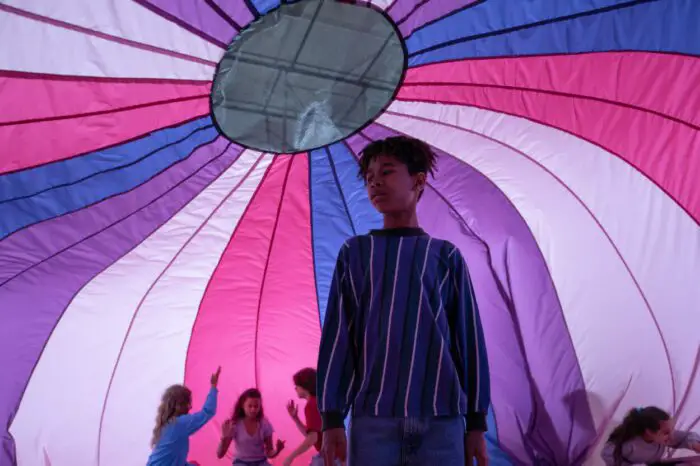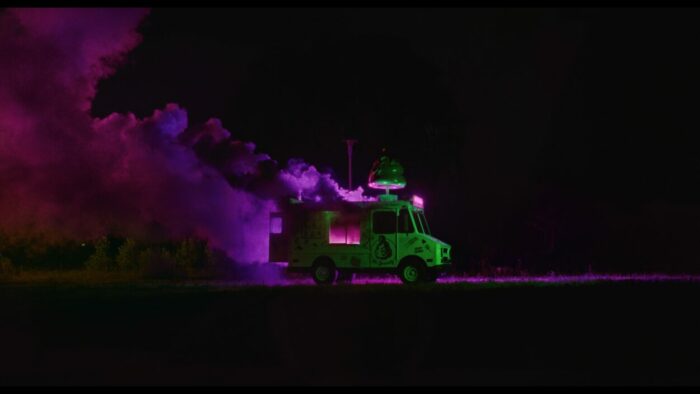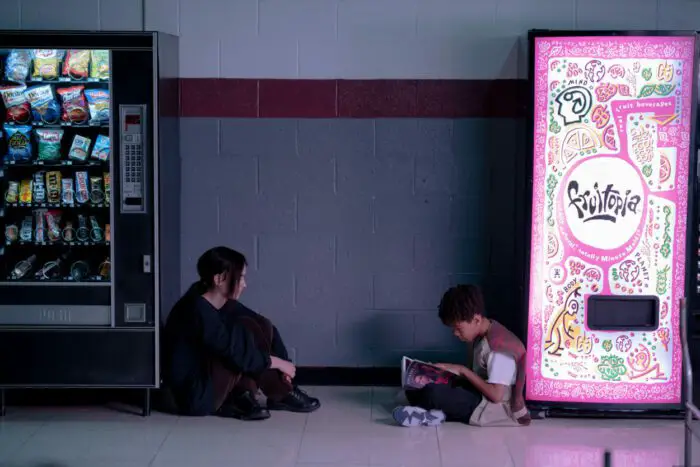Identity is at the center of Jane Schoenbrun’s hypnotic and unique I Saw the TV Glow. More specifically, finding your identity in your life is the journey the characters find themselves on. But, to blossom into your true self, you have to see it represented somewhere. Traditionally, we take after our parents, guardians, siblings, and even friends. The times are changing, though. Media and celluloid are constants in our lives, just like our family. In some situations, when the people in your life aren’t your main support system, you seek out support in movies, TV, music, social networking apps, and any other form of media. Perhaps you’re confused about what career you want to pursue, and an episode of E.R. changes your life. Or you discover a passion for cooking while watching The Food Network. Whatever the example may be, there is no denying that celluloid forms us.
And Schoenbrun seems dialed into that concept. Their debut feature, We’re All Going to the World’s Fair, was a coming-of-age horror movie about the internet (and creepypasta). Schoenbrun, a nonbinary director who uses they/them pronouns, incorporates trans themes into their breakthrough feature but fully explores the role of media on trans identity in their follow-up, I Saw the TV Glow. Pulling from their experience transitioning and being in that confusing period where someone like them didn’t know what to feel or how to feel or who to be, their personal imprint is all over this movie. Everything—from the big moments to the suburban milieu to the ‘90s vernacular—feels lived in and realized. Steven Spielberg explored his parents’ disillusioned marriage in The Fabelmans and the role it played in him becoming a director. Lee Isaac Chung used his family’s immigration story in Minari to show the importance of the sacrifices our parents make to allow us to thrive. Continuing in this singular tradition, Schoenbrun shows us how TV can change someone’s life.
Owen (played mostly by Justice Smith) is a confused high-schooler who can’t figure out why he doesn’t fit in. His parents are unable to understand the phase he’s in, none more than his toxic father Frank (Fred Durst). He meets an older classmate, Maddy (Brigette Lundy-Paine), who introduces him to a supernatural show known as The Pink Opaque. Owen becomes enamored with the show. However, the more he gets obsessed with the show, the lines between reality and fantasy start to blur and Owen finds his world changing completely.

When watching I Saw the TV Glow, it’s important to go in sans any preconceived notion about the type of movie you’re about to see. Some people may describe it as a horror movie; others will call it a coming-of-age drama. To me, this movie is genre-less. It would be a disservice to this distinctive feature by putting it in a box. The film’s core thesis is that we are put into a box too fast. We aren’t encouraged nor are we given enough time to become the person we are comfortable being. At times, I Saw the TV Glow is unsettling. But it is also funny, sweet, and melancholic. If I had to give it a genre, I would describe it as atmospheric.
Essentially, this is a vibes movie. And, how much you connect to it depends on if you can get on its wavelength. This is not Wes Craven or John Carpenter. Schoenbrun is working in the same oeuvre as David Lynch, David Cronenberg, and Terrance Malick. The filmmaking in I Saw the TV Glow is being executed at an expert level. The intentional use of colors is remarkable. Owen’s story is not an easy one but everything he’s going through is contrasted with the use of bright neon colors, particularly pink. In fact, pink and blue are seen in most scenes of this movie—Schoenbrun isn’t hiding their metaphor but doesn’t rely on exposition to convey it.
Their approach to creating an ominous mood is bold because they don’t handhold you to get through this movie. Similar to Owen, we the audience aren’t always able to decipher what’s real and what’s not. But, perhaps this is the effect Schoenbrun is going for. They want us to put ourselves in Owen’s shoes and view the world from his perspective—disorienting and frightening. It’s incredibly effective and cements them as one of the most exciting emerging directors.

The music, original songs, and needle drops in I Saw the TV Glow are quite astonishing. Again, in addition to arresting visuals, Schoenbrun uses music to add to the ambiance. Phoebe Bridgers, Caroline Polachek, Kristina Esfandiari, and many other contemporary artists are featured on this amazing soundtrack but their placement never feels off. Most of the movie takes place in the ‘90s but the music feels akin to the state of mind Owen and Maddy are in. This is music they would be listening to and, maybe in an alternate reality like The Pink Opaque, they are.
Speaking of The Pink Opaque, let’s talk about it. This is the fictional ‘90s supernatural show that Maddy introduces to Owen, who then becomes obsessed with it. This show (and Maddy to an extent) becomes Owen’s biggest companion. When he sits down to watch The Pink Opaque, those 30 minutes are the only time during his day when he feels seen. The pretend characters and the outlandish situations in the show feel more tangible to him than the trials and tribulations of his life. But, even with representation, the idea of The Pink Opaque frightens Owen. He is seen for the first time. That also means he has to confront his true identity for the first time and that’s scary. The TV’s glow casts a shadow on him as if they are projecting his true self onto his make-believe self. If The Pink Opaque represents a fictional life, then wouldn’t Owen’s current reality be fictional? That to me, is what I Saw the TV Glow is about.

There are going to be a lot of reads, think pieces, and takes on the meaning of I Saw the TV Glow. I think some are going to be frustrated by its ambiguity (and I believe the movie can veer too far into surrealism losing the audience on this journey), but I think Schoenbrun is too talented to make a film that only has a single reading. This was a very personal task for them to create this movie and that jumps off the screen. They want people to watch this movie, latch onto the ideas and visuals, and find a way to connect to it.
Both Smith and Lundy-Paine are undeniable, however. Smith is an exciting actor and this is his strongest work yet. I found his performance to be devastating and I feel I can still hear his shrieks and screams days after seeing the film. It’s a nuanced performance, a lot of it non-verbal. But, Smith fits this world perfectly and completely sinks into the character of Owen. Lundy-Paine—who was electric in the third Bill and Ted movie—comes and goes in the narrative, but when she’s present, she is a force to be reckoned with. It’s a sharp and confident performance and her talent is on display in a third-act monologue. I won’t say much, but I was pretty floored by it: the delivery, the writing, the execution, just everything about that scene. Keep an eye out for some cool cameos that Schoenbrun sprinkles in throughout the movie.
I Saw the TV Glow is a genuinely exciting movie. Very few people are making movies that feel so structurally and directionally unique. I really can’t compare it to any other movie and that’s what’s so cool about. Schoenbrun is inspired by many of the directors I mentioned above, but don’t get anything mixed up. There are shades of Lynch, Malick, and Cronenberg, but this is a Jane Schoenbrun movie, through and through. There is no comparison for it and there probably won’t be one until, maybe, Schoenbrun’s third feature. But, I’d bet a lot of money their third movie will be drastically different. Even if it’s a movie adaptation of the shoddy Pink Opaque, I will be seated. Because, if anyone can make that into an important and one-of-a-kind feature, it’s Schoenbrun.




